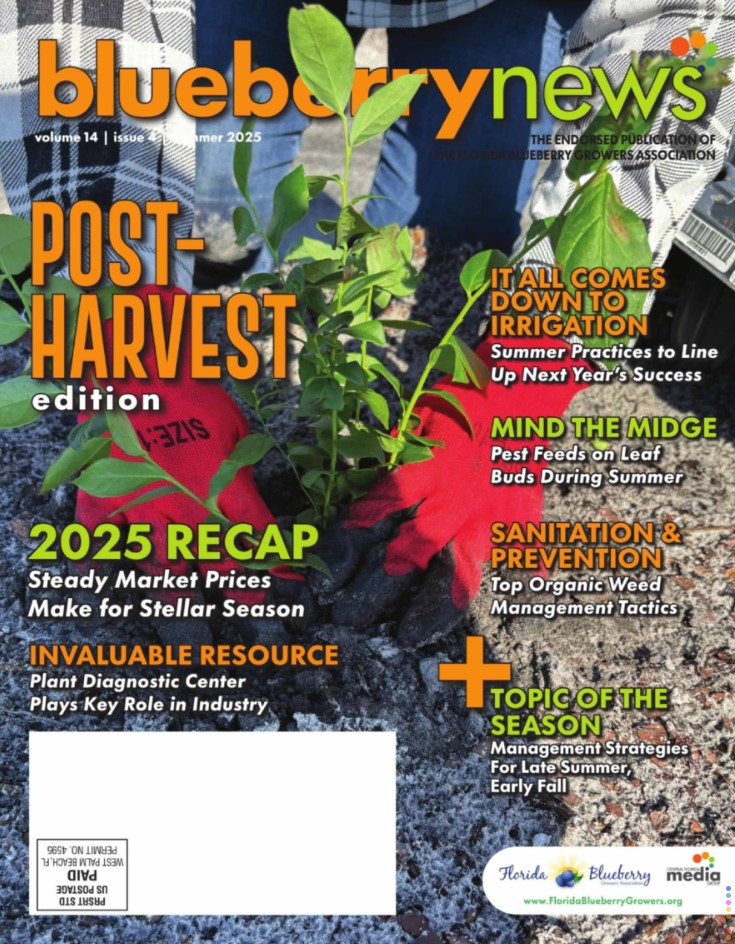Flower Thrips Threaten Fruit Quality, Quantity
The Florida flower thrips (Frankliniella bispinosa Morgan) are a pest of southern highbush blueberries in Florida that are present during bloom. Larvae and adults feed on all parts of the flowers (ovaries, styles, petals) and developing fruit. Feeding damage can reduce pollination of the injured blooms, and therefore the quantity and quality of fruit produced from those blooms. Adult females can also cause indirect injury to fruit when laying their eggs inside flower tissues (Figure 1 c). The newly hatched larvae create holes in the flower tissue when they emerge, resulting in scarring of the fruit.
Figure 1 a-c. Flower thrips injury
Credits: O. Liburd, UF/IFAS (Figure 1 b and c). UF/IFAS (Figure 1 a).
Flower thrips have a short life cycle (18 to 22 days under ideal conditions), which includes two active feeding larval stages, completing multiple generations in blueberry during the spring each year. Adults are very small (1/16 of an inch in length), yellowish to orange in color, with fringed wings (Figure 2). Thrips numbers typically increase dramatically as the flower corollas open and bloom progresses.
Figure 2. Adult flower thrips
Credits: O. Liburd, UF/IFAS
Determining when or if blueberries should be treated for thrips can be difficult. To measure treatment thresholds for southern highbush blueberries, begin sampling bloom clusters as soon as flowers begin to open. Sample four to five areas in a 1-acre block by placing a white sheet of paper under a flower cluster and tapping lightly. Count the number of flowers in the cluster, and also the number of thrips dislodged from the flower cluster. If there is an average of more than four thrips per flower, some type of management is recommended. Alternatively, two white sticky traps can be used to monitor a 5-acre block (one on the border of the block and one in the center). If there are more than 80–100 thrips in the traps per week, some type of management is needed.
Blueberries are a pollination-sensitive crop, and careless use of insecticides and subsequent bee kill can easily impair pollination and impact fruit-set. Only selected insecticides (such as Delegate®) should be used during bloom. If Delegate® (spinetoram) is used, the insecticide should be applied in the early morning or late evening and given three hours of drying time before bees are allowed to forage on the crop. Assail® (acetamiprid) and Apta® (tolfenpyrad) are the material of choice only until five days pre-bloom. Sivanto® (flupyradifurone) and Entrust® (Spinosad) also have some efficacy on flower thrips.
Resources
-
Frankliniella bispinosa Morgan (Insecta: Thysanoptera: Thripidae) (http://entnemdept.ufl.edu/creatures/VEG/THRIPS/Frankliniella_bispinosa.htm)
-
2022 Florida Blueberry Integrated Pest Management Guide (https://edis.ifas.ufl.edu/publication/HS380)
-
UF/IFAS Blueberry Growers Guide app (https://tosto.re/blueberryuf)
CREDITS:
DR. OSCAR LIBURD, Professor, UF/IFAS
& DOUG PHILLIPS, Blueberry Extension Coordinator, UF/IFAS





